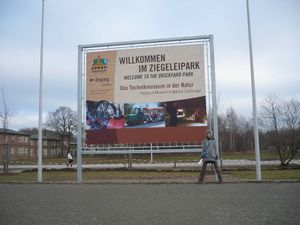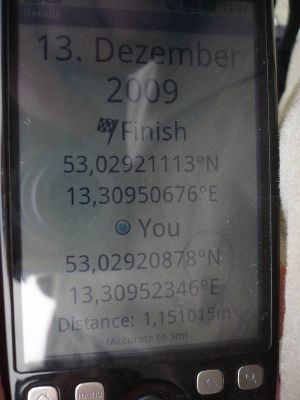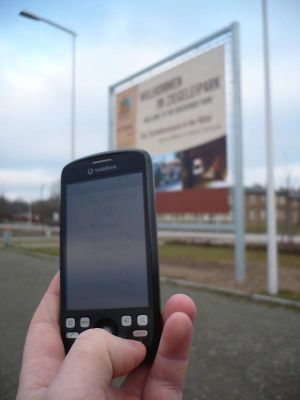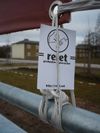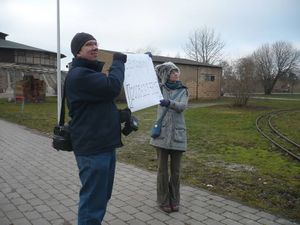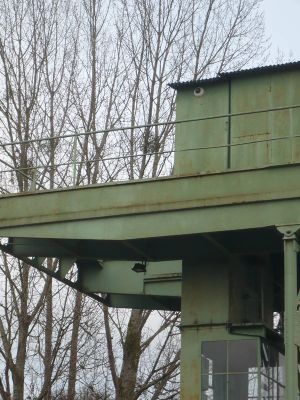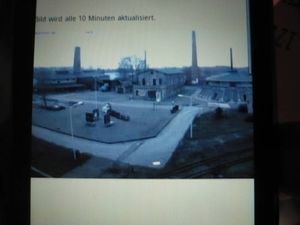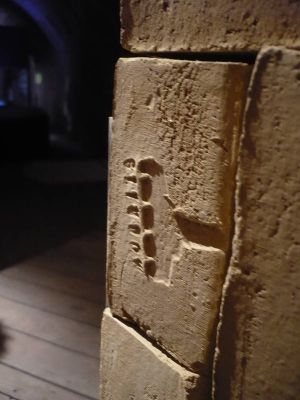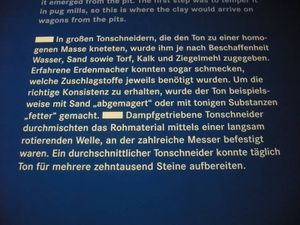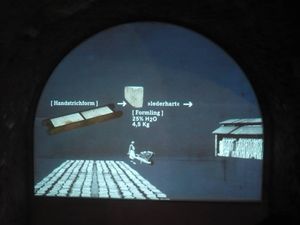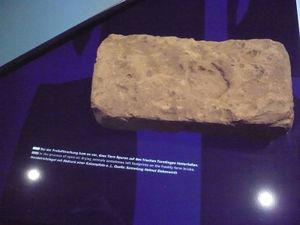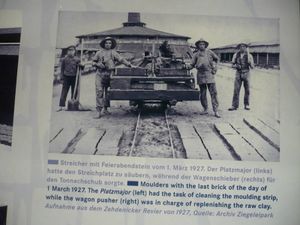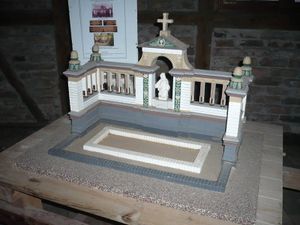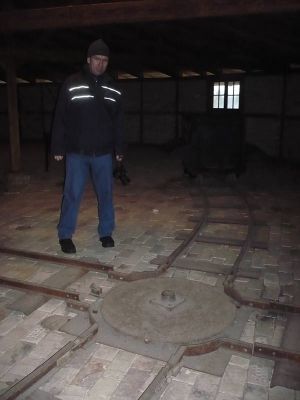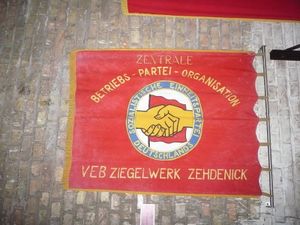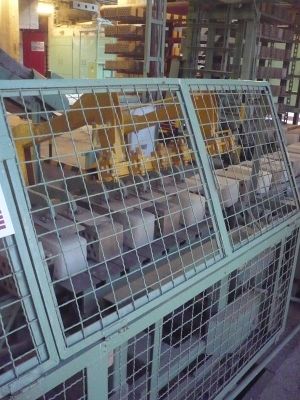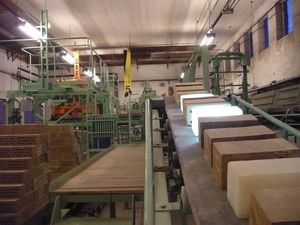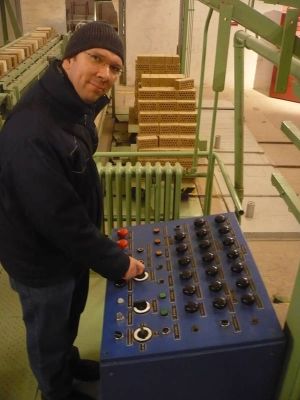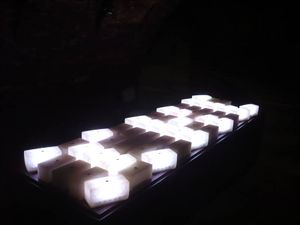2009-12-13 53 13
| Sun 13 Dec 2009 in 53,13: 53.0292111, 13.3095068 geohashing.info google osm bing/os kml crox |
Location
On the parking of Ziegeleipark (Brickworks museum & park) Mildenberg. This should be a nice complement to our former visit at the brickworks in Glindow in 52 12.
http://ziegeleipark.de/index.php?id=66
webcam - could that be the parking space? showing the entrance of the museum.
Participants
Plans
There is a webcam. And a museum open 12-16. The opportunity for hashcards may arise.
I am planning to set off in Berlin at roughly 11am, probably by car. Whose it shall be is yet to be determined, but there are always carsharing options at Hauptbahnhof.
Expedition
After explaining all the awesomeness of visiting another brickworks museum to lyx, and an elaboration of the possible activities to do, relet managed to convince lyx to join him. Phoenix was convinced with a short message mentioning the coordinates and a call in the morning to confirm the availability of fair weather. And so it happened that Phoenix picked us up, a little after noon, and we drove to Mildenberg.
We parked on the official car park, in the location where relet expected the hash to be. After turning on a GPS however, we discovered that the car park must have grown since the creation of the satellite photos, and the hash location turned out to be rather close to a huge billboard advertising the brickworks park.
The hash itself lay about five meters in front of the billboard, with a slight slant towards the exit. And so we gathered, took the obligatory photos (yet to be uploaded by Phoenix) and left a card.
Our next station was the location of the webcam, which we would soon have identified as the entrance of the museum. Having read that the webcam took an update every ten minutes, and knowing that there had been a picture taken at a 10:59:54, we assumed that it would capture us roughly every full ten minutes. So we gathered at 13:59, holding our marker into the camera, and waited for two minutes. Which is when it got cold. We then left the marker on the ground, while relet tried to have our success confirmed by the IRC crowd.
The marker was successfully captured by the webcam, as these images show. However, the result was a bit disappointing, as neither the marker was not readable at the given distance, nor could anyone confirm that a picture had been taken at 13:50 - the ones captured show us at 14:00 investigating the many little work trains standing in front of the museum. Still a yay for being in the picture!
We then proceeded to the entrance of the museum. The nice lady explained that there would only be two exhibits open during the winter - the kiln and the production facilities. Also, that there would be a movie starting every half hour in the theatre, and that we should time our visit. After having seen the single-tower museum in Glindow, little did we expect the interactive, multimedial masterwork that would await us. And indeed, after entering the circular kiln, we saw a familiar sight. Some of the bricks stacked here bore the stamp of the Glindow brickworks. The reason would be, I assume, that Glindow still has a functional kiln, which is used to reproduce bricks for historical buildings, and so would be able to produce the bricks for this exhibition. The city of Berlin is full of (more or less) historical brickwork buildings.
The plaque to the right explains, at least in the German version, that a skilled earth maker would be able to determine the necessary ingredients to prepare a good clay by tasting the earth. The raw clay earth can be mixed with various ingredients to establish the correct level of moisture and porosity for the process.
Maybe the classiest part of the exhibition though were the Monty-Python-styled animations explaining the invention of the circular kiln and the life and tasks of the workers. A circular kiln is used, because it allows for a continuous operation: The fire burns its way around the cir^Woval, coal is added through holes in the roof, and roughly at the opposite side of the kiln, new bricks are stacked and the burnt ones removed.
That is not all however! Here's a video of the whole production process as recreated by Phoenix. The earth is dug out, transported to the brickworks, mixed, burnt, dried, and shipped to Berlin. The manual labour of shaping the bricks and laying them out to dry have been skipped though.
Brick slides helped to load the bricks onto the boats - one by one.
Our bridge building abilities, which we were able to prove later, seemed to be thwarted by the detection technology, but after arranging a few bricks, we finally succeeded and celebrated with a victory dance to the suspense-y music.
Above the kiln itself lay the stoker's chamber, where coal could be poured through circular holes into the various parts of the kiln. It also exhibited a biography of the constructor and inventor of the circular kiln, and owner of the factory. I shall have to compare the model of it's grave with the original, which is situated in a central cemetery in Berlin. There were also some items of work safety - helmets and gloves mostly, but apparantly they had considered some breathing mask against the omnipresent clay dust. Apparently they were too quickly congested to be useful.
We then proceeded to the more modern facilities used in the former GDR. This included a full range of earth mixing, brick cutting and brick stacking machinery, but still a noteworthy amount of manual labor. We calculated that a single cart full of bricks weighed more than a ton (but we might be wrong there) and was pushed by a single worker along the bumpy rails, and around the turntables on the ground.
The video in this video demonstrates the arrival of the raw earth and its transport to the mixer
Another highlight, which we had to capture in video was the facility where the dried bricks were restacked to be delivered to the kiln, removing the aluminum bars they were drying on. Phoenix soon discovered the main control panel, whose buttons were linked to the appropriate sounds of the machinery: video

